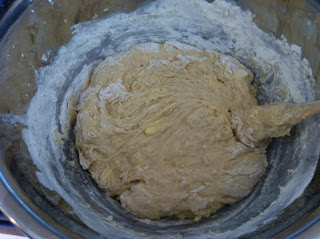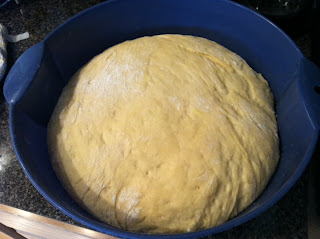Since we've seriously overdone cake to celebrate work birthdays lately, I opted to make cinnamon rolls to help ring in several coworkers birthdays. I've made and blogged these before, but I've never done the "step by step" blog which I'm told will be useful for those not used to working with yeast and dough.
This recipe is courtesy of what seems like a thousand year old cookbook. It was my grandmother's. The cover fell off when I was five. Pages are stuck together from all the exposure to ingredients in the kitchen. I'm surprised you can still see some of the recipes. This cookbook and her china are the two things I inherited from my grandmother. This is just back story to a delicious sweet roll, but on some level I believe the fact that the recipe comes from this cookbook makes the rolls that much more delicious. As hokey as it sounds, they are truly made with love.
Some people's family heirlooms are priceless jewels, mine is a cookbook.
This actually explains a lot about who I am.
This actually explains a lot about who I am.
Now, down to the business of making cinnamon rolls.
To make the dough:
Ingredients
1 package active dry yeast
1/2 cup warm water (105 to 115 degrees F)
1/2 cup scalded milk, cooled to lukewarm
1/3 cup sugar
1/3 cup shortening or butter, softened
1 teaspoon salt
1 egg
3 1/2 to 4 cups all purpose flour
Begin by taking your shortening or butter out of the refrigerator and leaving it to soften on the counter. Then place a generous 1/2 cup of milk in a small sauce pan over medium heat. The recipe doesn't specify a type, I generally use 1% with no problem. The goal here is to scald the milk. To do this, allow the milk to heat very slowly until it comes almost to a boil, where it has many small bubbles all over the top of the milk. Do NOT allow it to come to a full, rolling boil or else you will scorch the bottom of the pan. Keep a close eye on the milk as it's very easy to go from scalded to scorched if left unattended.
Once your milk has reached scalding, take it off the heat, pour it into a coffee mug and set it aside to cool to lukewarm. This is something else to watch closely. It will take some time for the milk to begin to cool appreciably. But once it does, it will go from warm to lukewarm to cool quickly. You need to use it in its lukewarm state.
In the last few minutes of your milk cooling, dissolve the package of active dry yeast in the 1/2 cup of warm water in a large mixing bowl. Whisk to ensure all the granules dissolve.
Stir in the lukewarm milk and egg. Whisk to combine.
To make the dough:
Ingredients
1 package active dry yeast
1/2 cup warm water (105 to 115 degrees F)
1/2 cup scalded milk, cooled to lukewarm
1/3 cup sugar
1/3 cup shortening or butter, softened
1 teaspoon salt
1 egg
3 1/2 to 4 cups all purpose flour
Begin by taking your shortening or butter out of the refrigerator and leaving it to soften on the counter. Then place a generous 1/2 cup of milk in a small sauce pan over medium heat. The recipe doesn't specify a type, I generally use 1% with no problem. The goal here is to scald the milk. To do this, allow the milk to heat very slowly until it comes almost to a boil, where it has many small bubbles all over the top of the milk. Do NOT allow it to come to a full, rolling boil or else you will scorch the bottom of the pan. Keep a close eye on the milk as it's very easy to go from scalded to scorched if left unattended.
This milk has been scalded and is ready to be removed from the heat.
Once your milk has reached scalding, take it off the heat, pour it into a coffee mug and set it aside to cool to lukewarm. This is something else to watch closely. It will take some time for the milk to begin to cool appreciably. But once it does, it will go from warm to lukewarm to cool quickly. You need to use it in its lukewarm state.
In the last few minutes of your milk cooling, dissolve the package of active dry yeast in the 1/2 cup of warm water in a large mixing bowl. Whisk to ensure all the granules dissolve.
Dissolve yeast and warm water after whisking
Stir in the lukewarm milk and egg. Whisk to combine.
Don't let the two eggs confuse you, I made a double batch when taking these photos
Add in the sugar, salt, shortening or butter and enough flour for the dough to begin to pull away from the sides of the bowl when you mix it (anywhere from 1 to 2 cups). At this point, trade in your whisk for a wooden spoon to combine all the ingredients. Add the flour slowly since you don't want to add anymore than you need. Too much flour makes any bread dough heavy and, combined with overhandling, tough.
Even though it was left out to soften, don't be surprised if your butter or shortening doesn't fully incorporate. That's actually okay since any pockets of cool butter will create steam in the baking process leading to lighter, fluffier sweet rolls.
Now comes the tricky part, knowing how much more flour to add. While the recipe calls for 3 1/2 to 4 cups in total, how much flour you need really is a matter of paying attention to how your dough responds. I like to slowly add about a 1/2 cup at a time until the dough starts to really pull away from the side of the bowl and come together. On average this happens after the first 1/2 cup to 1 cup. It looks like this.
Note that it's still not smooth, but it's no longer extremely
sticky and is starting to form a ball in the middle of the bowl.
At this point it's ready to knead. Cover a clean, flat surface with more flour. Turn your dough out on that surface. Sprinkle the top of the dough with more flour to keep it from sticking to your hands. Also dip your hands in flour, believe me, this will help. Knead the dough, add more flour as necessary, until it comes together and can easily be shaped into a rounded ball. This doesn't take long. Try not to over handle the dough as this will make it tough. Once your dough looks like this...
...you're ready to place it in a greased bowl to begin rising. Place the dough in a warm spot in your kitchen (not too close to the stove though) with a towel over the bowl and allow to rise until it has doubled in size, usually about 1 1/2 hours. You'll know it's done when you can poke it and your finger impression remains behind.
Now that the dough has risen, you're ready to make the actual cinnamon rolls. Just before you're ready to roll out the dough, zap about 3 tablespoons of butter in the microwave for 30 seconds to melt it. In another bowl, combine 1/3 cup of sugar and two tablespoons of cinnamon. Return your dough to the clean, flat, floured surface. Punch the dough down. Roll the dough out with a rolling pin coated in flour. Do the best you can to roll the dough into a rectangle, about 15" x 9". Brush the melted butter all over your rolled out dough, including the edges. Sprinkle very liberally with the cinnamon/sugar mixture, again, all the ways to the edges. If you like raisins* or nuts** in your cinnamon rolls, sprinkle those items liberally across the dough as well.
Roll the dough up into a tight log, pinching the edges of the roll to seal it up tightly. Cut into 1 1/2 inch slices and place upright in a greased 9x9x2 pan. Set aside in a warm spot and allow to rise again until double, usually about an hour. Heat the oven to 375 degrees F. Bake until golden brown, about 25 to 30 minutes.
When the rolls are removed from the oven, allow them to cool for 30 minutes and then glaze them (they'll still be warm, just not hot). To make the glaze, combine 1 cup powdered sugar with 1 to 2 tablespoons of milk and a 1/2 teaspoon vanilla until smooth. Brush liberally over the warm cinnamon rolls.
*For raisins, I recommend reconstituting them by soaking a cup or so in two cups of boiling water (from your tea pot is fine) for a few hours before using them.
**Chopped pecans or walnuts are the best in cinnamon rolls as they hold up well to the baking process and I'm told are very complimentary flavors (credit to B here since I don't eat nuts).









No comments:
Post a Comment